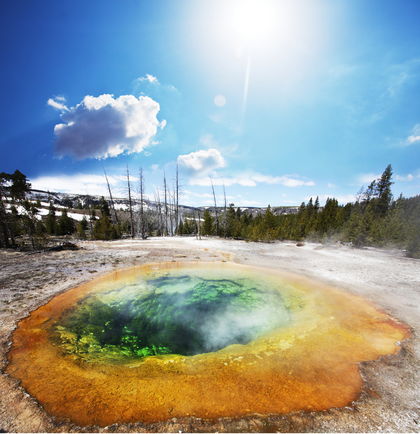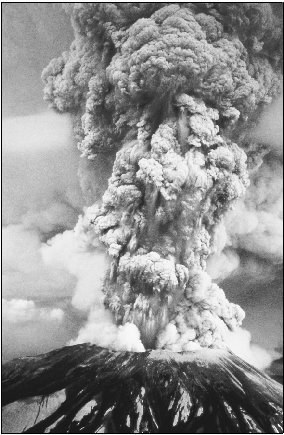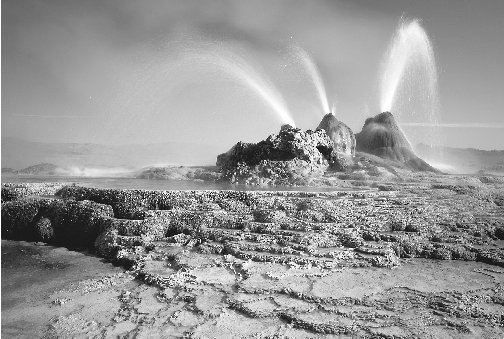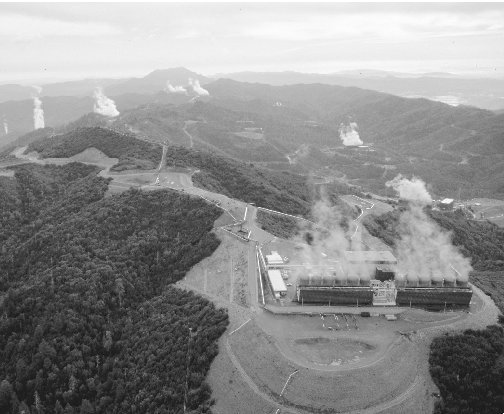Chapter 5
Geothermal Power

Scientists theorize that 15 billion years ago, when the universe was first forming, all matter exploded and released huge amounts of energy. It is this energy that still fuels the sun. It also produces the heat energy found inside the earth, which can be harnessed to create what is called geothermal power.
The earth is in a constant state of change with shifting tectonic plates, erupting volcanoes, and ongoing modification of its internal structures. There are several methods for utilizing geothermal power being explored and developed, but the changing nature of the energy source complicates the process. New technologies are being developed to address these issues, however, which gives new promise for geothermal power as a viable energy source.
Where Geothermal Energy Comes From
When the earth was first forming, about 5 billion years ago, an immense amount of energy was released. Some of this energy was used to bond molecules together very tightly at the center of the earth. These molecules are made mostly of iron and nickel, and they form the inner core of the earth, which is estimated to be about 755 miles in diameter. The earth's inner core, which is relatively cold and solid, is surrounded by an outer core. The outer core, which is a liquid made of the same types of molecules, has a thickness of about 1,410 miles.
Surrounding the outer core of the earth is the mantle. The mantle is about 1,790 miles thick and is made mostly of iron and magnesium. Unlike the core, which is part solid, part liquid, the mantle is completely liquid. It has an average temperature of about thirty-three hundred degrees Fahrenheit. This is very hot and can even melt rocks.

As geological time went on, the earth's surface began to cool and a thin crust formed over the mantle. This crust is about 2.5 to 37 miles thick and is made of iron, magnesium, and aluminum. The crust covers the earth's surface and makes up all of the land and the ocean floor.
It is the interaction between the mantle of the earth and the earth's crust that makes geothermal power possible. The crust of the earth traps the heat of the mantle beneath it. Sometimes the heat of the mantle becomes so intense that it causes the mantle to break through at the thinnest areas of the crust. These areas are referred to as hot spots. The material in the mantle can escape at hot spots in the form of volcanic lava. When a volcano erupts, it is basically allowing the mantle of the earth to flow up through the crust to the surface.
The heat from the mantle can also come into contact with water in the earth's crust. Underground water sometimes forms large pools and rivers in the crust. When this water comes in contact with the heat of the mantle, it becomes superheated and travels through cracks in the crust to the surface. In this heated state, the water exerts great pressure on the surrounding rocks. The rocks then crack and allow the water to move. The boiling hot water then pushes up through the crust and shoots into the air. This type of geological feature is called a geyser. Yellowstone National Park has many of these geysers, the most famous of which is Old Faithful.
Vents, or cracks and openings, in the earth's crust allow water in the crust to be continuously heated by the mantle. These vents are responsible for such geothermal features as hot springs and geothermal wells full of heated water. The water does not break though the crust and shoot into the air, but is slowly leaked out in the form of steam. These types of hot spots can be found on almost every continent in the world.
Harnessing Geothermal Energy
The heat energy transferred from the mantle to the waters in the earth's crust can be harnessed to create electricity. This can happen in three different ways. Dry steam reservoirs harness the energy of geysers to produce electricity. Wet steam reservoirs use recycled water to make steam deep in the geothermal wells that are heated by the mantle of the earth. Hot water reservoirs create a supply of heated water from underground sources that can be used to heat homes and businesses.
Dry Steam Reservoirs
Dry steam reservoirs use the water in the earth's crust, which is heated by the mantle and released through vents in the form of steam. Dry steam reservoir geothermal plants have pipes that are drilled into the site and used to trap the steam. The steam is then used to turn turbines connected to a generator to produce electricity. This is a highly efficient system for making electricity and has been used by humans for many decades. A large dry steam reservoir near Larderello, Italy, has powered local electric railroads for about one hundred years.
The underground water reservoirs that feed such a system are refilled when rain falls on the land. The rainwater eventually soaks back into the crust of the earth. Because this occurs on a continuous basis, geothermal energy is considered a renewable resource.
About 6 percent of the energy used in northern California is produced at twenty-eight dry steam reservoir plants found at The Geysers dry steam fields in northern California. At peak production, these geothermal power plants can produce up to two thousand megawatts of electricity an hour. That is about twice the amount of electricity a large nuclear power plant can produce.
Wet Steam Reservoirs
Sometimes, however, dry steam reservoirs do not refill themselves in a very consistent manner. They can also have a lower temperature, which results in a less effective combination of water droplets and steam mixed together. Geothermal operators have found a solution to these problems by building wet steam reservoirs. For a wet steam reservoir to work, a well is drilled into the geothermal site to release the steam, which can be anywhere from six hundred to fifteen hundred feet deep. After the steam that is piped up passes through and turns the turbines in the power plant on the surface, it is sent into a condenser, which cools it. This cooled water can then be pumped back into the wells. The water is heated again by the mantle and released as steam. The steam turns the turbines again and produces more electricity. This process can happen over and over with a minimal loss of water. Although there are no current counts of the number of wet steam reservoir plants there are in the world, the largest are in New Zealand, Mexico, Japan, and the former Soviet Union.
Hot Water Reservoirs
Geothermal plants built over hot water reservoirs are more common than either dry steam or wet steam reservoir plants. Although the water in a hot water reservoir does not reach high enough temperatures to become steam, it is still valuable. The water itself does not produce electricity, but instead is piped through a network of pipes into the walls of nearby homes and businesses. The heat from the pipes radiates into the rooms, heating the air. Pipes return the water to the hot water reservoir to be reheated and introduced back into the system.
Reykjavik, Iceland, is surrounded by hot water reservoir sites and is also home to about eighty-five thousand people. Almost 80 percent of the homes in this town are heated using hot water reservoir water. There are about 180 locations in the United States that use hot water reservoirs to heat homes, as well as places such as the Utah State Prison in Bluffdale, which is heated solely by geothermal power. These sites could be expanded with further development and by connecting them to the utility company grids. The U.S. Department of Energy believes that developing these sites could produce thirty times more energy than the total amount of energy the country is currently using.

The Benefits of Geothermal Power
Using the water at geothermal power production sites, whether in the form of steam or hot water, does not deplete the water supply from the surrounding ecosystems as long as it is pumped back into the earth's crust. Because geothermal plants rely upon the interaction of water and molten rocks beneath the crust of the earth, they are also not dependent upon the weather or time of day to produce energy. In addition, the temperatures underground stay consistent throughout the year. For example, a wet water reservoir that has an internal temperature of nearly two thousand degrees Fahrenheit in the summer has the same temperature in the winter. This means geothermal power is available for use twenty-four hours a day, every day of the year. Unlike solar and wind power, the need for battery storage is eliminated because the energy needed to create electricity is always available. This is an attractive feature of any renewable resource.
While geothermal plants need additional replenishing of water supplies because the steam released exceeds the amount of water that naturally flows into the systems, some of these sites are starting to recycle wastewater through their systems as an alternative source of water. Wastewater is all of the water that leaves a home from the sinks, toilets, and outdoor hoses. Some cities are piping their wastewater to geothermal plants. These plants use the wastewater to refill their geothermal wells. The power plants are able to use this steam to create electricity just as if the water had naturally been in the crust of the earth. For example, the city of Santa Rosa, California, pipes its wastewater to its geothermal power plant to replenish the wells. The city receives power from the plant and the water is effectively recycled.
The process used by wet steam geothermal plants requires drilling into the earth's crust. As the hole is drilled, plant operators are left with a lot of sludge. If the sludge, which is often rich in zinc and sulfur, is released into the environment, these elements can be harmful. Fortunately for geothermal plant owners, these two elements can be extracted from the sludge and sold on the market. This also helps make the geothermal plants even more profitable.
Geothermal features, such as geysers and hot springs, are found throughout the world. Yet, to be used to produce geothermal power they must be large in size or have many sites located close together. This type of arrangement happens in only very specific areas on the earth. Countries that have these features, such as New Zealand, Iceland, and Indonesia, have a source of security. They do not have to rely upon other countries to supply energy to their cities and towns. This self-sufficiency allows these countries to make decisions based on what is best for them, not what will make other countries give them energy for a low price.
Advances in geothermal power production have made it competitive with more conventional methods of power production. New drilling techniques and technology, such as 3-D seismic technology as well as advanced directional drilling, which allows drillers to be able to hit an underground target the size of a closet over five miles from the drilling rig and thousands of feet down, help to lower geothermal power production costs. Other cost-saving measures, such as more advanced systems to capture steam, and more recycling of water, have also helped to decrease the cost of geothermal power. Currently, it costs about five cents per kilowatt-hour to produce electricity using geothermal energy, which is only slightly more than the cost of producing electricity by burning fossil fuels. As the price of natural gas and coal increases and the cost of geothermal power decreases, geothermal power is becoming more of an attractive alternative.
The Cost to the Environment
Geothermal power is considered a nonpolluting source of energy, but it does have some serious environmental drawbacks. Often, to develop a geothermal site, fragile

The steam used at geothermal plants can also become a source of air pollution if it is released into the atmosphere. Frequently it is heavily laced with salts and sulfur compounds that are leached from the earth's crust. If the steam is simply condensed and released into the natural waterways, the high levels of salts and sulfurs can be toxic to aquatic wildlife. If released into the air, the toxins, in the form of acid rain, can still find their way into surface water systems and kill aquatic animals. Geothermal plant operators often cool and condense the steam produced at their plants and recycle it into their wells for these reasons.
The sludge that is created by drilling wells for wet steam geothermal plants can also be a source of environmental pollution. This sludge often contains minerals that contaminate water supplies of local residences if it is not properly processed and disposed of. Aquatic wildlife can also be affected if this sludge is put into the water systems. Strict regulations are in place for most geothermal plants so that both steam and sludge are properly disposed of. However, this often increases the cost of producing geothermal power.
Other Drawbacks
Beyond the environmental impacts that geothermal power production has, there are other significant drawbacks. Geothermal power is not available for a large number of nations. Although geothermal vents are found throughout the world, they are only in large enough numbers to make geothermal power viable in few select areas. The United States has several sites in California and Hawaii. New Zealand, Iceland, and the islands of Indonesia are also rich in geothermal sites.
The basic dynamic of geothermal power can cause problems with energy production as well. Thermal vents, geysers, and hot spots tend to be unstable. Water, rock, and heat are in an ongoing state of interaction and movement, making thermal vent areas relatively uninhabitable. This means that most geothermal sites are in remote areas. Utility lines must be built to the geothermal site in order to carry the electricity to urban areas. This is a very expensive endeavor and often holds back utility companies from building geothermal plants.
Most forms of geothermal energy are not truly renewable resources. Dry steam plants can have problems with the steam at their sites finding new vents to travel through over time. If this occurs, the water would no longer be available to produce geysers and the geothermal plants that rely on these geysers would need to relocate. Wet steam reservoirs have to be constantly supplied with water to produce electricity. Hot water reservoirs can run out eventually and no longer supply water to heat homes. Yet, since there is so much water in the crust of the earth that is heated by the mantle, it is still considered a renewable resource. It is unlikely that there will ever come a time when water is not heated somewhere in the crust of the earth by the mantle. It is simply a matter of moving geothermal plants to these sites.
Many of these drawbacks to geothermal energy are inherent in its use; there is nothing that can be done to prevent them. There is no way a country can create geothermal features on its land if they do not naturally exist. There is also no available way to create water in sites that need constant replenishing.
Yet, as scientists explore the potential of geothermal power, they are discovering ways to minimize the environmental impact. For example, instead of building more plants, existing sites that were deemed used to capacity and closed are now able to be redrilled using techniques that allow for deeper penetration of the earth's crust. They are also developing systems that allow for steam to be recycled at the site. Perhaps as they progress in their discoveries, many of these challenges to geothermal power will simply become obstacles that were overcome through science.

The Future of Geothermal Power
Currently there are about twenty countries that harness the power of geothermal energy. The United States produces about 45 percent of all geothermal power in the world. Some scientists believe these numbers will increase, as they think the potential for geothermal power has not even begun to be explored. Simply using today's technology and applying it to all available geothermal sites would increase the output of electricity from about 8,240 megawatts to 70,000 megawatts. Using technologies that are being currently researched could increase this figure to as much as 138,000 megawatts. This would be enough power to continuously satisfy about 8 percent of all the energy needs in the world.
A new program called "GeoPowering the West" has been started by the U.S. Department of Energy. This program is designed to give scientists an opportunity to learn more about geothermal energy. Goals of the program include having 7 million homes using geothermal power by 2010, doubling the number of states producing geothermal electricity from four to eight by 2006, and reducing the cost of geothermal power to three cents per kilowatt-hour by 2007. Using the findings from these investigations, the United States will try to meet its goal of using geothermal energy to provide 10 percent of the energy needed by all western states by the year 2020. Kevin Rafferty, associate director for the Geo-Center at Oregon Institute of Technology, is cautious but optimistic about the future of geothermal energy. "Geothermal is unlikely to be the single answer to our energy security any more than wind, solar, conservation, or fossil fuels will be. It should be part of a mix of strategies." In any case, he says, "it can be a much larger part of the energy picture than it is now." 22
Scientists are also investigating better drilling techniques. It is hoped that they will discover a way to drill into the crust of the earth in the ocean without disturbing the natural cycles of the water. Oceanic crust was selected for these studies because this is where the crust of the earth is the thinnest—sometimes as little as ten miles thick—but still thick enough for drilling. If this investigation is successful, geothermal energy will become an unlimited supply of power for human use. No longer will humans have to rely on natural geothermal features to be able to build geothermal plants. Geothermal power will be able to power human needs for electricity for as long as the mantle of the earth remains hot, which scientists believe will be for hundreds of millions of years more.
diffirence between dry steam,wet steam and hot water field in geothermal resource with neat sketch